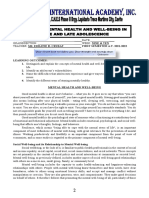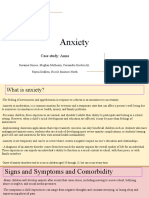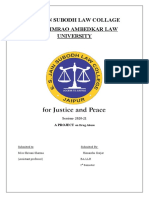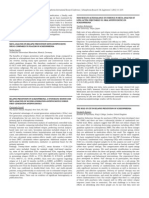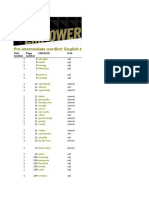0 ratings0% found this document useful (0 votes)
7 viewsNotes
Uploaded by
rowena.sapaulaCopyright
© © All Rights Reserved
Available Formats
Download as PPTX, PDF, TXT or read online on Scribd
0 ratings0% found this document useful (0 votes)
7 viewsNotes
Uploaded by
rowena.sapaulaCopyright
© © All Rights Reserved
Available Formats
Download as PPTX, PDF, TXT or read online on Scribd
You are on page 1/ 10
INSET 2022
“FIRE (FABINHS INSET
Reassuring
Education’s Quality)
AMIDST PANDEMIC”
February 3- 4, 2022
SESSION I: Promotion of Mental Health & Well –
Being (Source Speaker: Ms. Rosemarie Fabon (DLS)
What is Mental Health?
• It is a state of well – being in which every individual –
realizes his own potential, can cope with the normal stresses
of life, can work productively and fruitfully and is able to
make contributions to this community.
MENTAL HEALTH CONTINUUM:
Level of mental health – Healthy- Normal functioning – u can
do
all the tasks
Reacting – Common and reversible
distress
Injured – Severe and persistent functional
impairment
Ill – Clinical disorder Severe functional
impairment
MENTAL HEALTH FACTS:
1. One in four individuals will be affected by mental health or
neurodevelopmental problem at some point in their life.
2. Half of all mental health conditions start by 14 years of
age
3. Dpression and anxiety are the leading mental disorders.
4. Suicide is the thirs leading cause of death in 15 – 19 tears
old.
CHALLENGES THAT TEENS FACE IN THE PANDEMIC
• Students lost consistent access to friends and adult
supports
• Many students have taken on new responsibilities,
including childcare, housework and part – time jobs
• Challenges on learning modality
• Economic difficulties
EARLT WARNING SIGNS OF MENTAL HEALTH PROBLEMS
* Feeling numb or like nothing matters
* Having low or no energy
* Having unexplained aches and pains
* Feeling helpless or hopeless
* Smoking, drinking, or using drugs
* Thinking of harming yourself or others
* Feeling unusually confused, forgetful, on edge,
angry, upset, worred or acared
* Pulling away from people and usual activities
* Eating or sleeping too much or too little
* Inability to perform daily tasks like getting to
work or school
FREQUENCY : How often do you experience the problem?
INTENSITY: How much is it affecting your daily
functioning?
DURATION: How long have you been experiencing the
problem?
COMMON MENTAL HEALTH PROBLEMS THAT AFFECT
CHILDREN AND YOUNG PEOPLE
* Depression * Self – harm * Eating Disorders
* Generalized anxiety disorder * Conduct Disorder,
Developmental
disorders
* PTSD
DEPRESSION (Major Depression Disorder)
A common and serious medical illness that negatively
affects how you eel, the way you think and how you act
It causes feelings of sadness and/or a loss of interest in
activities you once enjoyed
It can leas to a variety of emotional and physical problems
and can decrease your ability to function at work and at
home
SIGNS ANG SYMPTOMS OF DEPRESSION
• Depressed mood
• Marked diminished interest or feeling ne pleasure
• Significant weight loss when not dieting or weight gain
• Insomnia or hypersomnia
• Restlessness
• Fatigue, tiredness, or loss of energy nearly every day
• Feelings of worthlessness and or inappropriate guilt
• Diminished ability to think or concentrate or
indecisiveness
• Recurred thoughts of death/suicide
ANXIETY - refers to anticipation of a future concern and is
more associated with muscle tendion and avoidance behavior
FEAR – is an emotional response to an immediate threat and
is ore associated with a fight or flight reaction 0 either staying
to fight or leaving to escape danger
ANXIETY DISORDERS – differ from normal feelings of
nervousness or anxiousness and involve excessive fear or
anxiety
SINGS AND SYMPTOMS OF ANXIETY
PHYSICAL – panic attacks, hot and cold flushes, racing heart,
tightening of the chest, quick breathing, restlessness, or
feeling tense, wound up and edgy
PSYCHOLOGICAL – excessive fear, worry, catastrophizing or
obsessive thinking
BEHAVIORAL – avoidance of situations that make you feel
anxious which can impact on study, work or social life
*** Mental health problems are common but help is available.
People with mental health problems can get better and many
recover completely.
WHO Model for School Mental Health Promotion
Entire School Community – Create environments which
promote mental and emotional well –being and positive
social interactions
All students and teachers – Mental health education,
knowledge, attitude and behavior
20% to 30% of students – Targeted early prevention
program
3% to 12% of students – Professional intervention
ENVIROMENT AND GENERAL ETHOS
ACCOMODATION
GENETAL ETHOS
* All contribute to the promotion of caring and
welcoming environment
* High Staff morale with good mowing relationsthip
* Respectful relationships are fostered between staff
and between staff and students
* Students and staff feel a sense of belonging and self –
worth
* Mental health and well –being of students and staff
are prioritized and protected.
SUPPORT FOR STAFF
* Management assist the staff to work collectively so
that trust, respect and confidence are evident throughout the
school
* All staff feel that their views are listened to and taken
seriously within the school
* Stagg feel that they receives recognition and support
from management
* Staff feel that their efforts and abilities are noted and
rewarded and that their worl is worthwhile and successful
>PARTNERSHIP WITH STUDENTS
* Students participation is valued in the school and
student are actively encouraged and supported
* Staff listen to and take full account of the views of
students
* Students know that their feelings and views are
values
* There are structure in the school which allow students
to have a voice (e.g. student council)
HOW TO BUILD CARING RELATIONSHPS WITH STUDENTS?
1. Get to know your students and learn their names.
2. Be genuine in your interaction – be unique in your
approach
3. Use humor in your relationships
4. Praise in public and correct in private
MENTAL HEALTH IN THE GENERAL CURRICULUM
• Providing knowledge about mental health and disorders
• Information about attitudes and behaviors related to
positive mental health (e.g. strategies for dealing with
stress; help seeking; coping with lass and grief;
managing and reducing interpersonal conflicts; problem
solving)
EXAMPLES OF SCHOOL - WIDE ACTIVITIES FOR MENTAL
HEALTH PROMOTION
* Parent tutoring program
* New Student welcoming committee
* Cross age mentoring for students
* Book clubs for students or parents
* Art festival showcasing student work
* Workshops for parents to teach communication
skills
* Peer mediation
* Peace circles
* Bullying prevention activities
CLASSROOM BASED PREVENTIVE PROGRAMS: BUILDING PSYCHOSOCIAL COMPETENCE
**** To achieve flourishing life, we must promote PERMA – V
P – Positive emotions
Ways to build positive emotions;
* Spending time with people you care about
* Doing activities that you enjou (hobbies)
* Listening to uplifting or inspirational music
* Reflecting on things you are grateful for and what is going well in your life
E – Engagement
Ways to Increase Engagement:
* Participate in activities that you really love, where you lose track of time
when you do them
* Practice living in the moment, even during daily activities or mundane tasks.
* Spend time in nature, watching, listening, and observing what happens
around you
* Identify and learn about your character strengths, and do things that you
excel at
R – Relationships
Ways to build relationships:
* Join a class or group that interests you
* Ask questions of the people you don’t know well to find out about them
* Create friendships with people you are acquainted with
* Get in tough with people you have not spoken to or connected with in a
while
M – Meaning
Ways to build meaning:
* Get involved in a cause or organization that matters to you
* Try new, creative activities to find things you connect with
* Think about how you can use your passions to help others
* Spend quality time with people you care about
A – Accomplishments
Ways to build accomplishments:
* Set goals that are SMART (specific, measurable, achievable, realistic, and
time bound)
* Reflect on past successes
* Look for creative ways to celebrate your achievements
V – Vitality
Ways to promote vitality“:
* Optimism * Physical Activity * Nutrition * Sleep
TEACHING STUDENTS COPING SKILLS IN A WHOLE
CLASSROOM SETTING
1. Normalize anxiety, stress, worry
2. Teach students signs of when they stressed,
overwhelmed, worried
3. Teach students to ask for a break when they are
feeling overwhelmed
4. Teach relaxation strategies you can do as a class
(deep breathing, count to 10, write in a journal,
draw, color, or scribble, read, visualization etc.)
TEACHING STUDENTS PROBLEM SOLVING SKILLS IN
A WHOLE CLASSROOM SETTING
Identify the problem situation
Consider the Options for the situation
List the Disadvantages and Advantages of each
option
Choose a Solution and follow through
SESSION II : POSITIVE DISCIPLINE TOWARDS
BEHAVIOR MANAGEMENT
(Source Speaker: Mr. Edmundo Fetalvero MT-AP)
SAVE THE CHILDREN
You might also like
- 2 - YDS Importance of Mental Health Amid Covid 19 AnislaganNo ratings yet2 - YDS Importance of Mental Health Amid Covid 19 Anislagan21 pages
- Addressing Mental Health in Secondary EducationNo ratings yetAddressing Mental Health in Secondary Education12 pages
- Advisory For University Students 0105 PDFNo ratings yetAdvisory For University Students 0105 PDF7 pages
- Q1 PPT - PE - HEALTH 7 Week 1 - Lesson 1No ratings yetQ1 PPT - PE - HEALTH 7 Week 1 - Lesson 122 pages
- Ten Things You Can Do For Your Mental Health: 1. Value YourselfNo ratings yetTen Things You Can Do For Your Mental Health: 1. Value Yourself15 pages
- Mental Health Awareness Orientation: Helping Young Minds Find A Better Place100% (2)Mental Health Awareness Orientation: Helping Young Minds Find A Better Place35 pages
- Pe&Health 7.quarter 1.week 1 Matatag Curriculum100% (3)Pe&Health 7.quarter 1.week 1 Matatag Curriculum56 pages
- Q1 PPT - Pe and Health 7 - Week 1 - Lesson 1No ratings yetQ1 PPT - Pe and Health 7 - Week 1 - Lesson 138 pages
- GROUP 2 Mental Health Program and PoliciesNo ratings yetGROUP 2 Mental Health Program and Policies12 pages
- Wellbeing PPT Uts-Presentation-5-Nov-2014No ratings yetWellbeing PPT Uts-Presentation-5-Nov-201443 pages
- SRNHS-P.E. and Health 7-Lesson-Exemplar-Lesson 1-Weeks 1-2No ratings yetSRNHS-P.E. and Health 7-Lesson-Exemplar-Lesson 1-Weeks 1-29 pages
- Hec101V - Exam Revision May/June 2016: Section ANo ratings yetHec101V - Exam Revision May/June 2016: Section A56 pages
- 123mm0666 Sanidhya Jindal Personality Development 3rd SemesterNo ratings yet123mm0666 Sanidhya Jindal Personality Development 3rd Semester21 pages
- 123ID0906 - Swostideep Nayak - Personality DevelopmentNo ratings yet123ID0906 - Swostideep Nayak - Personality Development24 pages
- Community Service Project (19) - Naga SravyaNo ratings yetCommunity Service Project (19) - Naga Sravya22 pages
- module3creatinghealthycaringrelationships-240213172722-41d438d0No ratings yetmodule3creatinghealthycaringrelationships-240213172722-41d438d018 pages
- the four before: A Resource · A Reference · A Refresher For Instructional StakeholdersFrom Everandthe four before: A Resource · A Reference · A Refresher For Instructional StakeholdersNo ratings yet
- A Comparative Study To Assess The Quality of Life Among Mothers After Normal Vaginal Delivery and Caesarean SectionNo ratings yetA Comparative Study To Assess The Quality of Life Among Mothers After Normal Vaginal Delivery and Caesarean Section4 pages
- S.S. Jain Subodh Law Collage Dr. Bhimrao Ambedkar Law UniversityNo ratings yetS.S. Jain Subodh Law Collage Dr. Bhimrao Ambedkar Law University18 pages
- The Role of CBT in Relapse Prevention of SchizophreniaNo ratings yetThe Role of CBT in Relapse Prevention of Schizophrenia2 pages
- Module 5 Mental Health, Adjustment and Mental HygeineNo ratings yetModule 5 Mental Health, Adjustment and Mental Hygeine14 pages
- USDA APHIS Pet Travel - Bringing Pet Dogs Into The United StatesNo ratings yetUSDA APHIS Pet Travel - Bringing Pet Dogs Into The United States2 pages
- PDF (Ebook) Handbook of Pharmacogenomics and Stratified Medicine by Sandosh Padmanabhan (ed.) ISBN 9780123868824, 0123868823 download100% (1)PDF (Ebook) Handbook of Pharmacogenomics and Stratified Medicine by Sandosh Padmanabhan (ed.) ISBN 9780123868824, 0123868823 download71 pages
- Diagnosis of Antiphospholipid SyndromesNo ratings yetDiagnosis of Antiphospholipid Syndromes25 pages
- Traits of A Healthy Nuclear Safety Culture INPO 12 012 Rev.1 Apr2013No ratings yetTraits of A Healthy Nuclear Safety Culture INPO 12 012 Rev.1 Apr201338 pages
- Health Optimizing Physical Education 3: Self-Assessment Activities For A Healthier MeNo ratings yetHealth Optimizing Physical Education 3: Self-Assessment Activities For A Healthier Me21 pages
- Recommender System For Personalized Health and Fitness Plans-Research PaperNo ratings yetRecommender System For Personalized Health and Fitness Plans-Research Paper9 pages
- Final Fichas de Seguridad Dekton 10-09-2022 enNo ratings yetFinal Fichas de Seguridad Dekton 10-09-2022 en16 pages
- Hodgkin's Lymphoma of The Nodular Subtype Is Associated WithNo ratings yetHodgkin's Lymphoma of The Nodular Subtype Is Associated With9 pages
- 2 - YDS Importance of Mental Health Amid Covid 19 Anislagan2 - YDS Importance of Mental Health Amid Covid 19 Anislagan
- Ten Things You Can Do For Your Mental Health: 1. Value YourselfTen Things You Can Do For Your Mental Health: 1. Value Yourself
- Mental Health Awareness Orientation: Helping Young Minds Find A Better PlaceMental Health Awareness Orientation: Helping Young Minds Find A Better Place
- SRNHS-P.E. and Health 7-Lesson-Exemplar-Lesson 1-Weeks 1-2SRNHS-P.E. and Health 7-Lesson-Exemplar-Lesson 1-Weeks 1-2
- 123mm0666 Sanidhya Jindal Personality Development 3rd Semester123mm0666 Sanidhya Jindal Personality Development 3rd Semester
- 123ID0906 - Swostideep Nayak - Personality Development123ID0906 - Swostideep Nayak - Personality Development
- module3creatinghealthycaringrelationships-240213172722-41d438d0module3creatinghealthycaringrelationships-240213172722-41d438d0
- the four before: A Resource · A Reference · A Refresher For Instructional StakeholdersFrom Everandthe four before: A Resource · A Reference · A Refresher For Instructional Stakeholders
- From surviving to thriving: A mental health workbookFrom EverandFrom surviving to thriving: A mental health workbook
- A Comparative Study To Assess The Quality of Life Among Mothers After Normal Vaginal Delivery and Caesarean SectionA Comparative Study To Assess The Quality of Life Among Mothers After Normal Vaginal Delivery and Caesarean Section
- S.S. Jain Subodh Law Collage Dr. Bhimrao Ambedkar Law UniversityS.S. Jain Subodh Law Collage Dr. Bhimrao Ambedkar Law University
- The Role of CBT in Relapse Prevention of SchizophreniaThe Role of CBT in Relapse Prevention of Schizophrenia
- Module 5 Mental Health, Adjustment and Mental HygeineModule 5 Mental Health, Adjustment and Mental Hygeine
- USDA APHIS Pet Travel - Bringing Pet Dogs Into The United StatesUSDA APHIS Pet Travel - Bringing Pet Dogs Into The United States
- PDF (Ebook) Handbook of Pharmacogenomics and Stratified Medicine by Sandosh Padmanabhan (ed.) ISBN 9780123868824, 0123868823 downloadPDF (Ebook) Handbook of Pharmacogenomics and Stratified Medicine by Sandosh Padmanabhan (ed.) ISBN 9780123868824, 0123868823 download
- Traits of A Healthy Nuclear Safety Culture INPO 12 012 Rev.1 Apr2013Traits of A Healthy Nuclear Safety Culture INPO 12 012 Rev.1 Apr2013
- Health Optimizing Physical Education 3: Self-Assessment Activities For A Healthier MeHealth Optimizing Physical Education 3: Self-Assessment Activities For A Healthier Me
- Recommender System For Personalized Health and Fitness Plans-Research PaperRecommender System For Personalized Health and Fitness Plans-Research Paper
- Hodgkin's Lymphoma of The Nodular Subtype Is Associated WithHodgkin's Lymphoma of The Nodular Subtype Is Associated With







